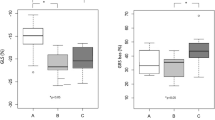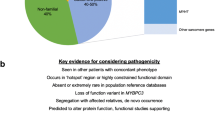Abstract
Identification of the first echocardiographic manifestations of hypertrophic cardiomyopathy may be important for clinical management and our understanding of the pathogenesis. We studied the development of pre-diagnostic echocardiographic changes in young relatives to HCM patients during long-term years follow-up. HCM-relatives not fulfilling the diagnostic criteria for HCM and age of <18 years were included in this study. We performed echocardiographic evaluations at inclusion and after 12 ± 1 years follow-up. Based on family screening of 11 sarcomere genes, CRYAB, α-GAL, and titin, we evaluated: (1) non-carriers (known family mutation ruled out-controls), (2) carriers (phenotype negative gene mutation carriers) and (3) phenotype negative relatives with unknown genetic status (relatives from families without identified mutations). At inclusion (age 11 ± 5 years), there were no differences in echocardiographic chamber dimensions, systolic or diastolic function between the three groups. During follow-up (age 23 ± 5 years), carriers (n = 8) developed lower left ventricular end-diastolic dimension (LVEDd) compared to non-carriers (n = 23) (41 ± 4 vs. 46 ± 4 mm; p = 0.04) and a higher ratio of early left ventricular filling velocity and early diastolic velocity of lateral mitral annulus (E/e’ 6 ± 1 vs. 5 ± 1; p = 0.003). No significant differences in LVEDd or E/e’ were found between relatives with unknown genetic status (n = 24) and non-carriers though Z-scores for these parameters were >2 in a subset of relatives with unknown genetic status. Children carrying pathogenic sarcomere gene mutations develop reduced LVEDd and increased E/e’ as first pre-diagnostic echocardiographic manifestations during follow-up into adulthood.



Similar content being viewed by others
References
Maron BJ, Seidman JG, Seidman CE (2004) Proposal for contemporary screening strategies in families with hypertrophic cardiomyopathy. J Am Coll Cardiol 44(11):2125–2132
Christiaans I, Birnie E, Bonsel GJ, Wilde AA, van Langen I (2008) Uptake of genetic counselling and predictive DNA testing in hypertrophic cardiomyopathy. Eur J Hum Genet 16(10):1201–1207
Andersen PS, Havndrup O, Hougs L, Sorensen KM, Jensen M, Larsen LA, Hedley P, Thomsen AR, Moolman-Smook J, Christiansen M, Bundgaard H (2009) Diagnostic yield, interpretation, and clinical utility of mutation screening of sarcomere encoding genes in Danish hypertrophic cardiomyopathy patients and relatives. Hum Mutat 30(3):363–370
Spirito P, Maron BJ (2001) Sudden death and hypertrophic cardiomyopathy. Lancet 357(9272):1975–1976
Gersh BJ, Maron BJ, Bonow RO, Dearani JA, Fifer MA, Link MS, Naidu SS, Nishimura RA, Ommen SR, Rakowski H, Seidman CE, Towbin JA, Udelson JE, Yancy CW (2011) ACCF/AHA guideline for the diagnosis and treatment of hypertrophic cardiomyopathy: a report of the American College of Cardiology Foundation/American Heart Association Task Force on Practice Guidelines. Circulation 124(24):e783–e831. doi:10.1161/CIR.0b013e318223e2bd
Elliott PM, Anastasakis A, Borger MA, Borggrefe M, Cecchi F, Charron P, Hagege AA, Lafont A, Limongelli G, Mahrholdt H, McKenna WJ, Mogensen J, Nihoyannopoulos P, Nistri S, Pieper PG, Pieske B, Rapezzi C, Rutten FH, Tillmanns C, Watkins H (2014) ESC guidelines on diagnosis and management of hypertrophic cardiomyopathy: the task force for the diagnosis and management of hypertrophic cardiomyopathy of the European society of cardiology (ESC). Eur Heart J 35(39):2733–2779. doi:10.1093/eurheartj/ehu284
Kaski JP, Syrris P, Esteban MT, Jenkins S, Pantazis A, Deanfield JE, McKenna WJ, Elliott PM (2009) Prevalence of sarcomere protein gene mutations in preadolescent children with hypertrophic cardiomyopathy. Circ Cardiovasc Genet 2(5):436–441
Van Driest SL, Ommen SR, Tajik AJ, Gersh BJ, Ackerman MJ (2005) Yield of genetic testing in hypertrophic cardiomyopathy. Mayo Clin Proc 80(6):739–744
Ho CY, Abbasi SA, Neilan TG, Shah RV, Chen Y, Heydari B, Cirino AL, Lakdawala NK, Orav EJ, Gonzalez A, Lopez B, Diez J, Jerosch-Herold M, Kwong RY (2013) T1 measurements identify extracellular volume expansion in hypertrophic cardiomyopathy sarcomere mutation carriers with and without left ventricular hypertrophy. Circ Cardiovasc Imaging 6(3):415–422. doi:10.1161/CIRCIMAGING.112.000333
Germans T, Russel IK, Gotte MJ, Spreeuwenberg MD, Doevendans PA, Pinto YM, van der Geest RJ, van der Velden J, Wilde AA, van Rossum AC (2010) How do hypertrophic cardiomyopathy mutations affect myocardial function in carriers with normal wall thickness? Assessment with cardiovascular magnetic resonance. J Cardiovasc Magn Reson 12:13. doi:10.1186/1532-429X-12-13
Germans T, Wilde AA, Dijkmans PA, Chai W, Kamp O, Pinto YM, van Rossum AC (2006) Structural abnormalities of the inferoseptal left ventricular wall detected by cardiac magnetic resonance imaging in carriers of hypertrophic cardiomyopathy mutations. J Am Coll Cardiol 48(12):2518–2523. doi:10.1016/j.jacc.2006.08.036
Ho CY, Sweitzer NK, McDonough B, Maron BJ, Casey SA, Seidman JG, Seidman CE, Solomon SD (2002) Assessment of diastolic function with Doppler tissue imaging to predict genotype in preclinical hypertrophic cardiomyopathy. Circulation 105(25):2992–2997
Nagueh SF, Bachinski LL, Meyer D, Hill R, Zoghbi WA, Tam JW, Quinones MA, Roberts R, Marian AJ (2001) Tissue Doppler imaging consistently detects myocardial abnormalities in patients with hypertrophic cardiomyopathy and provides a novel means for an early diagnosis before and independently of hypertrophy. Circulation 104(2):128–130
Cardim N, Perrot A, Ferreira T, Pereira A, Osterziel KJ, Reis RP, Correia JF (2002) Usefulness of Doppler myocardial imaging for identification of mutation carriers of familial hypertrophic cardiomyopathy. Am J Cardiol 90(2):128–132
Forsey J, Benson L, Rozenblyum E, Friedberg MK, Mertens L (2013) Early changes in apical rotation in genotype positive children with hypertrophic cardiomyopathy mutations without hypertrophic changes on two-dimensional imaging. J Am Soc Echocardiogr. doi:10.1016/j.echo.2013.10.012
Jensen MK, Havndrup O, Christiansen M, Andersen PS, Diness B, Axelsson A, Skovby F, Kober L, Bundgaard H (2013) Penetrance of hypertrophic cardiomyopathy in children and adolescents: a 12-year follow-up study of clinical screening and predictive genetic testing. Circulation 127(1):48–54. doi:10.1161/CIRCULATIONAHA.111.090514
Bundgaard H, Havndrup O, Andersen PS, Larsen LA, Brandt NJ, Vuust J, Kjeldsen K, Christiansen M (1999) Familial hypertrophic cardiomyopathy associated with a novel missense mutation affecting the ATP-binding region of the cardiac beta-myosin heavy chain. J Mol Cell Cardiol 31(4):745–750
Havndrup O, Bundgaard H, Andersen PS, Larsen LA, Vuust J, Kjeldsen K, Christiansen M (2000) A novel missense mutation, Leu390Val, in the cardiac beta-myosin heavy chain associated with pronounced septal hypertrophy in two families with hypertrophic cardiomyopathy. Scand Cardiovasc J 34(6):558–563
Havndrup O, Bundgaard H, Andersen PS, Allan LL, Vuust J, Kjeldsen K, Christiansen M (2003) Outcome of clinical versus genetic family screening in hypertrophic cardiomyopathy with focus on cardiac beta-myosin gene mutations. Cardiovasc Res 57(2):347–357
Andersen PS, Havndrup O, Bundgaard H, Larsen LA, Vuust J, Pedersen AK, Kjeldsen K, Christiansen M (2004) Genetic and phenotypic characterization of mutations in myosin-binding protein C (MYBPC3) in 81 families with familial hypertrophic cardiomyopathy: total or partial haploinsufficiency. Eur J Hum Genet 12(8):673–677
Havndrup O, Christiansen M, Stoevring B, Jensen M, Hoffman-Bang J, Andersen PS, Hasholt L, Norremolle A, Feldt-Rasmussen U, Kober L, Bundgaard H (2010) Fabry disease mimicking hypertrophic cardiomyopathy: genetic screening needed for establishing the diagnosis in women. Eur J Heart Fail 12(6):535–540
Lang RM, Bierig M, Devereux RB, Flachskampf FA, Foster E, Pellikka PA, Picard MH, Roman MJ, Seward J, Shanewise JS, Solomon SD, Spencer KT, Sutton MS, Stewart WJ (2005) Recommendations for chamber quantification: a report from the American society of echocardiography’s guidelines and standards committee and the chamber quantification writing group, developed in conjunction with the European association of echocardiography, a branch of the European society of cardiology. J Am Soc Echocardiogr 18(12):1440–1463
Ostman-Smith I, Devlin AM (2001) A simple method for assessing the regression or progression of ventricular hypertrophy in the growing child and adult: the value of left ventricular wall-to-cavity ratios. Eur J Echocardiogr 2(1):22–30
Dubois D, Dubois EF (1919) A formula to estimate the approximate surface area if height and weight be known. Arch Intern Med 17:863–871
van Dijk SJ, Paalberends ER, Najafi A, Michels M, Sadayappan S, Carrier L, Boontje NM, Kuster DW, van Slegtenhorst M, Dooijes D, dos Remedios C, ten Cate FJ, Stienen GJ, van der Velden J (2012) Contractile dysfunction irrespective of the mutant protein in human hypertrophic cardiomyopathy with normal systolic function. Circ Heart Fail 5(1):36–46. doi:10.1161/CIRCHEARTFAILURE.111.963702
Pasquale F, Syrris P, Kaski JP, Mogensen J, McKenna WJ, Elliott P (2012) Long-term outcomes in hypertrophic cardiomyopathy caused by mutations in the cardiac troponin T gene. Circ Cardiovasc Genet 5(1):10–17. doi:10.1161/CIRCGENETICS.111.959973
Acknowledgments
This study was supported by the Lundbeck foundation (Grant No. R7-A675-B311), Dagmar Marshalls Fond and The A.P. Møller Foundation for the Advancement of Medical Science.
Conflict of interest
Authors have no conflicts of interests.
Author information
Authors and Affiliations
Corresponding author
Rights and permissions
About this article
Cite this article
Jensen, M.K., Havndrup, O., Christiansen, M. et al. Echocardiographic evaluation of pre-diagnostic development in young relatives genetically predisposed to hypertrophic cardiomyopathy. Int J Cardiovasc Imaging 31, 1511–1518 (2015). https://doi.org/10.1007/s10554-015-0723-x
Received:
Accepted:
Published:
Issue Date:
DOI: https://doi.org/10.1007/s10554-015-0723-x




